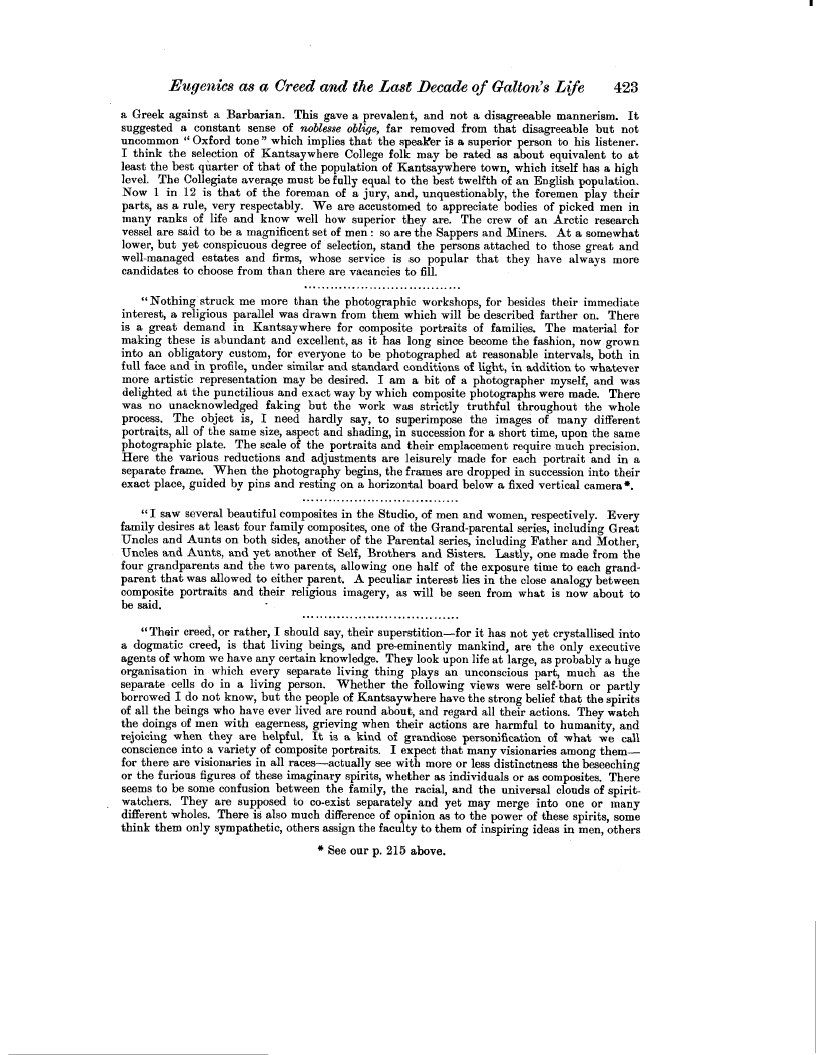| ||||||

OCR Rendition - approximate
Eugenics as a Creed and the Last Decade of Galton's Life 423 a Greek against a Barbarian. This gave a prevalent, and not a disagreeable mannerism. It suggested a constant sense of noblesse oblige, far removed from that disagreeable but not uncommon "Oxford tone" which implies that the spealeer is a superior person to his listener. I think the selection of Kantsaywhere College folk may be rated as about equivalent to at least the best quarter of that of the population of Kantsaywhere town, which itself has a high level. The Collegiate average must be fully equal to the best twelfth of an English population. Now 1 in 12 is that of the foreman of a jury, and, unquestionably, the foremen play their parts, as a rule, very respectably. We are accustomed to appreciate bodies of picked men in many ranks of life and know well how superior they are. The crew of an Arctic research vessel are said to be a magnificent set of men: so are the Sappers and Miners. At a somewhat lower, but yet conspicuous degree of selection, stand the persons attached to those great and well-managed estates and firms, whose service is so popular that they have always more candidates to choose from than there are vacancies to fill. .................................... "Nothing struck me more than the photographic workshops, for besides their immediate interest, a religious parallel was drawn from them which will be described farther on. There is a great demand in Kantsaywhere for composite portraits of families. The material for making these is abundant and excellent, as it has long since become the fashion, now grown into an obligatory custom, for everyone to be photographed at reasonable intervals, both in full face and in profile, under similar and standard conditions of light, in addition to whatever more artistic representation may be desired. I am a bit of a photographer myself, and was delighted at the punctilious and exact way by which composite photographs were made. There was no unacknowledged faking but the work was strictly truthful throughout the whole process. The object is, I need hardly say, to superimpose the images of many different portraits, all of the same size, aspect and shading, in succession for a short time, upon the same photographic plate. The scale of the portraits and their emplacement require much precision. Here the various reductions and adjustments are leisurely made for each portrait and in a separate frame. When the photography begins, the frames are dropped in succession into their exact place, guided by pins and resting on a horizontal board below a fixed vertical camera*. .................................... "I saw several beautiful composites in the Studio, of men and women, respectively. Every family desires at least four family composites, one of the Grand-parental series, including Great Uncles and Aunts on both sides, another of the Parental series, including Father and Mother, Uncles and Aunts, and yet another of Self, Brothers and Sisters. Lastly, one made from the four grandparents and the two parents, allowing one half of the exposure time to each grandparent that was allowed to either parent. A peculiar interest lies in the close analogy between composite portraits and their religious imagery, as will be seen from what is now about to be said. .................................... "Their creed, or rather, I should say, their superstition-for it has not yet crystallised into a dogmatic creed, is that living beings, and pre-eminently mankind, are the only executive agents of whom we have any certain knowledge. They look upon life at large, as probably a huge organisation in which every separate living thing plays an unconscious part, much as the separate cells do in a living person. Whether the following views were self-born or partly borrowed I do not know, but the people of Kantsaywhere have the strong belief that the spirits of all the beings who have ever lived are round about, and regard all their actions. They watch the doings of men with eagerness, grieving when their actions are harmful to humanity, and rejoicing when they are helpful. It is a kind of grandiose personification of what we call conscience into a variety of composite portraits. I expect that many visionaries among themfor there are visionaries in all races-actually see with more or less distinctness the beseeching or the furious figures of these imaginary spirits, whether as individuals or as composites. There seems to be some confusion between the family, the racial, and the universal clouds of spiritwatchers. They are supposed to co-exist separately and yet may merge into one or many different wholes. There is also much difference of opinion as to the power of these spirits, some think them only sympathetic, others assign the faculty to them of inspiring ideas in men, others * See our p. 215 above.
|